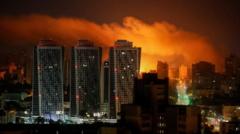Is Russia's Drone War Undermining Ukrainian Morale?

The Current State of Air Attacks in Kyiv: A City Under Siege
Kyiv, the resilient capital of Ukraine, has faced numerous challenges since the onset of the ongoing conflict. In recent months, however, the city has witnessed a disturbing escalation in air attacks, characterized by large-scale drone and missile strikes. This article delves into the current situation, examining the implications for Kyiv's residents and the broader context of the conflict. Furthermore, we will explore the capabilities of the drones used in these attacks and the strategies employed to counter them.
A Resilient Population Facing New Threats
The people of Kyiv have shown remarkable resilience over the past three and a half years. They have endured fluctuating fortunes, but the latest wave of air assaults marks a troubling shift in the nature of the conflict. Reports indicate that these attacks are becoming more coordinated and frequent, involving hundreds of drones and missiles targeting urban areas. For many residents, the terror of air raids has returned, prompting them to seek shelter in bomb shelters, metro stations, and underground car parks—a grim reminder of the early days of the war.
First-Hand Accounts
Eyewitness accounts from residents underscore the fear and anxiety permeating the city. Katya, a resident of Kyiv, described the experience: "The house shook like it was made of paper. We spent the entire night sitting in the bathroom." Svitlana recounted her experience, saying, "I went to the parking for the first time. The building shook, and I could see fires across the river." Such narratives reveal the profound psychological toll these attacks are inflicting upon civilians.
The Human Cost of Air Strikes
The UN's Human Rights Monitoring Mission in Ukraine (HRMMU) reported a staggering increase in civilian casualties. June saw the highest monthly death toll in three years, with 232 fatalities and over 1,300 injuries. This surge in violence is not restricted to frontline areas; cities far removed from the conflict have also borne the brunt of attacks. Danielle Bell, head of HRMMU, emphasized, "The surge in long-range missile and drone strikes across the country has brought even more death and destruction to civilians far away from the frontline."
How Air Strikes Affect Civilians
The emotional and psychological impact of these air strikes on civilians is profound. Children, in particular, are grappling with a new understanding of mortality, as illustrated by the poignant moment shared by Mariia, a grandmother who recounted her 11-year-old grandson's realization of death during an air raid. Such experiences can leave lasting scars on the psyche of young individuals, shaping their perception of safety and security.
The Evolution of Drone Warfare
Initially, Iranian-supplied Shahed drones were viewed as a novelty in the conflict. However, they have since become a familiar and fearsome sight in the skies above Ukraine. The design modifications made to the Shahed drones have significantly enhanced their capabilities, allowing them to fly at greater altitudes and carry heavier payloads. The range of these drones has increased to approximately 2,500 kilometers, making them a formidable threat to urban centers like Kyiv.
Technical Advancements and Tactical Changes
- Increased Altitude: New modifications allow drones to operate at higher altitudes, making them more difficult to detect and intercept.
- Enhanced Payload: The payload capability has increased from around 50 kg to 90 kg, allowing for more destructive attacks.
- Decoy Strategy: Many drones deployed in attacks are decoys designed to overwhelm Ukraine's air defense systems.
These advancements illustrate a shift in the dynamics of warfare, where quantity often outweighs quality. The sheer number of drones being deployed in coordinated attacks can stretch Ukraine's defense capabilities to their limits, creating a precarious situation where residents are left vulnerable to air strikes.
Strategies to Counter Drone Attacks
As the frequency and intensity of drone attacks escalate, Ukraine's defense forces are under increasing pressure to find effective countermeasures. The challenge lies not only in intercepting the drones but also in managing the limited resources available for air defense.
Resource Allocation and Defense Measures
Serhii Kuzan, a security expert, highlights the resource-intensive nature of countering drone swarms. "When production of particular missiles became too complicated, they concentrated on this particular type of drone and developed different modifications and improvements," he explains. This shift underscores the importance of strategic resource allocation, as Ukraine must decide how to best deploy its air defense systems to protect civilians while conserving valuable assets.
Key Defense Strategies Include:
- Enhanced Air Defense Systems: Requests for advanced missile systems, such as Patriot missiles, have been made to Ukraine's allies to bolster air defenses.
- Training and Preparedness: Ongoing training for military personnel in drone detection and interception techniques is essential for effective defense.
- Public Awareness Campaigns: Educating civilians about emergency procedures during air strikes can help mitigate panic and improve safety.
The Role of International Support
Ukraine's efforts to bolster its air defense systems have garnered international attention, with countries like the United Kingdom pledging to provide additional support. A recent defense agreement will supply over 5,000 air defense missiles to Ukraine, a significant step toward enhancing the country's ability to protect its skies.
Future Implications
As drone technology continues to evolve, the conflict in Ukraine is likely to undergo further transformations. Experts urge the international community to remain vigilant and responsive to Ukraine's needs, ensuring that the nation is equipped to face the mounting challenges posed by aerial warfare.
Conclusion
The people of Kyiv are facing a new reality marked by the constant threat of drone and missile attacks. The psychological and emotional toll on civilians is profound, as they grapple with fear and uncertainty in their daily lives. As Ukraine seeks to bolster its air defenses, the importance of international support cannot be overstated. The resilience of Kyiv’s residents is commendable, but without adequate protection and resources, the future remains uncertain.
FAQs
What types of drones are being used in the attacks on Kyiv?
The attacks primarily involve Iranian-supplied Shahed drones, which have undergone modifications to enhance their range, payload capacity, and ability to evade detection.
How are civilians in Kyiv coping with the air attacks?
Civilians have been forced to seek shelter in bomb shelters, metro stations, and underground car parks. The psychological impact is significant, with many experiencing heightened fear and anxiety.
What steps is Ukraine taking to counter drone attacks?
Ukraine is enhancing its air defense systems, seeking international support for advanced missile technologies, and conducting training for military personnel to improve detection and interception capabilities.
As the conflict in Ukraine continues to evolve, how can the international community effectively support the nation in its fight against aerial attacks? #KyivUnderSiege #AerialWarfare #SupportUkraine
Published: 2025-07-10 16:12:04 | Category: world



